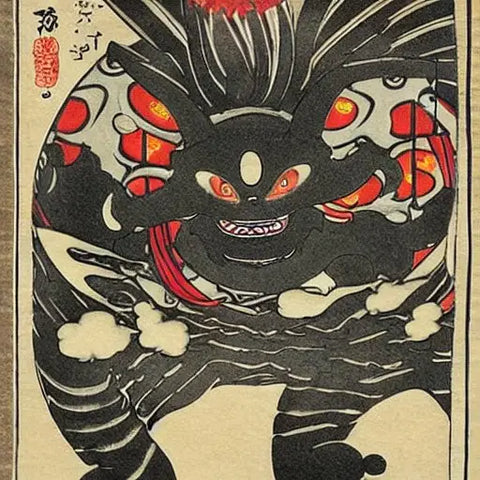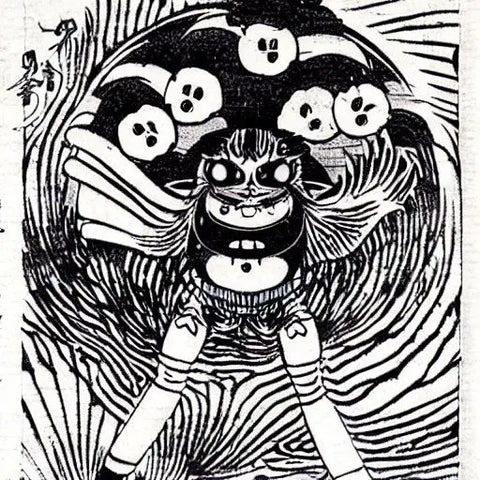
Tatarimokke
Share
The world of Japanese folklore is replete with a vast array of mythical creatures and supernatural beings, each possessing unique traits and stories. Among these fascinating entities is the Tatarimokke, a yokai that has captured the imaginations of many. In this article, we will delve into the realm of Tatarimokke, exploring its origins, legends, cultural significance, and more. Join us as we unravel the mysteries surrounding this enigmatic creature.
1. What is Tatarimokke?
Tatarimokke is a yokai, a class of supernatural creatures in Japanese folklore. Yokai are often depicted as mischievous, otherworldly beings that possess varying forms and characteristics. Tatarimokke, in particular, is known for its ability to disguise itself as a traditional Japanese ceiling or floor panel, commonly known as "tatami." This unique attribute sets it apart from many other yokai, adding to its allure and mystique.
2. The Origins of Tatarimokke
The origins of Tatarimokke can be traced back to ancient Japanese folklore. The term "Tatarimokke" is derived from two words: "tatami," referring to the traditional woven straw mats used in Japanese homes, and "mokke," which translates to "pillow" in English. The name hints at the yokai's ability to take the form of a tatami mat or a cushioned pillow.
3. Tatarimokke in Japanese Folklore
Tatarimokke has long been a prominent figure in Japanese folklore. It is believed that these yokai reside within old and abandoned houses, lurking in the shadows, waiting for unsuspecting victims to encounter them. Legend has it that Tatarimokke may suddenly transform into a large, monstrous creature, startling those who happen upon them.
4. Characteristics of Tatarimokke

Tatarimokke possesses several distinct characteristics that make it a truly intriguing yokai. Apart from its shape-shifting abilities, Tatarimokke is often described as having large, glowing eyes that radiate an eerie light. It is said to emit strange sounds and whispers, adding to the unsettling atmosphere it creates. Additionally, Tatarimokke is known for its mischievous nature, playing pranks on humans and causing disturbances within households.
5. Tatarimokke Legends and Stories
Throughout history, numerous legends and stories have emerged, recounting encounters with Tatarimokke. One popular tale tells of a weary traveler seeking shelter in an abandoned house, only to be greeted by a Tatarimokke disguised as a tatami mat. As the traveler unknowingly stepped on the yokai, it transformed into a monstrous creature, frightening the traveler and teaching a cautionary lesson about the perils of encountering unknown entities.
6. Symbolism and Cultural Significance of Tatarimokke
Tatarimokke holds symbolic meaning within Japanese culture. It represents the hidden dangers and secrets that lie within seemingly ordinary surroundings. The yokai serves as a reminder to be vigilant and aware of the supernatural forces that may exist alongside the everyday world.
7. Tatarimokke in Popular Culture
The enigmatic nature of Tatarimokke has captivated artists, writers, and filmmakers, leading to its inclusion in various forms of popular culture. From literature to anime and movies, Tatarimokke has left its mark, becoming an iconic figure in the realm of Japanese entertainment.
8. Tatarimokke Art and Merchandise
The allure of Tatarimokke extends beyond stories and legends. The yokai has inspired a wide range of artistic expressions, including paintings, sculptures, and illustrations. Additionally, Tatarimokke-themed merchandise, such as keychains, t-shirts, and plush toys, can be found, allowing enthusiasts to celebrate their fascination with this mysterious creature.
9. How to Summon Tatarimokke
Summoning Tatarimokke is not for the faint of heart, as it involves a delicate balance of rituals and precautions. While the specifics vary across different traditions, one common method involves creating a space reminiscent of an abandoned house, using old tatami mats and dim lighting. Chants and prayers are recited to attract the attention of Tatarimokke, with the hope of establishing communication with the yokai.
10. Tatarimokke Rituals and Practices

Various rituals and practices have emerged surrounding Tatarimokke. Some individuals perform ceremonies to seek protection from the yokai, while others strive to establish a connection and gain insight into the supernatural realm. These rituals often involve offerings, purification rituals, and recitation of specific prayers or incantations.
11. Tatarimokke as a Supernatural Entity
Tatarimokke's existence as a supernatural entity raises intriguing questions about the nature of yokai. While some consider Tatarimokke to be purely fictional, others believe in their existence, attributing paranormal encounters and unexplained phenomena to the presence of these mysterious creatures.
12. The Influence of Tatarimokke in Modern Society
Despite its ancient origins, Tatarimokke continues to captivate the modern imagination. Its depiction in literature, art, and popular culture showcases its enduring influence on Japanese society. The allure of Tatarimokke serves as a testament to humanity's enduring fascination with the supernatural and the unknown.
13. Tatarimokke and Other Yokai
Tatarimokke is just one of the countless yokai that populate Japanese folklore. Each yokai possesses its own unique characteristics, stories, and cultural significance. Exploring the connections and distinctions between Tatarimokke and other yokai allows for a deeper understanding of the rich tapestry of Japanese mythology.
14. Tatarimokke Sightings and Encounters
Tatarimokke sightings and encounters have been reported by individuals throughout history, further fueling the intrigue surrounding this elusive yokai. Numerous accounts describe eerie experiences and unexplained phenomena attributed to encounters with Tatarimokke.
Witnesses often recount hearing peculiar sounds or sensing a presence while in old, abandoned houses. Some claim to have seen a sudden movement or a glimpse of glowing eyes in the darkness, only for the creature to vanish moments later. Tatarimokke sightings are often associated with feelings of unease, sending shivers down the spines of those who cross paths with this mysterious yokai.
These encounters leave a lasting impression on individuals, leaving them with tales to share and adding to the rich tapestry of Tatarimokke lore.
15. Conclusion
In the vast tapestry of Japanese folklore, the Tatarimokke stands as a captivating and enigmatic figure. Its ability to transform into a seemingly innocuous tatami mat or pillow, coupled with its mischievous nature, has intrigued and captivated generations.
Tatarimokke's origins in ancient folklore, its prominence in Japanese culture, and its presence in popular media have solidified its status as a beloved and enduring yokai. Its symbolism, cultural significance, and connection to the supernatural realm continue to fascinate enthusiasts and researchers alike.
While the existence of Tatarimokke remains a subject of debate, its influence on Japanese mythology, art, and storytelling is undeniable. Whether encountered in the shadows of abandoned houses or admired through vibrant artwork and merchandise, Tatarimokke continues to enthrall and mystify.
Unveiling the secrets and unraveling the mysteries of Tatarimokke is a journey that invites us to explore the boundaries between the tangible and the intangible, the known and the unknown. As we venture into the realm of yokai, may we approach with wonder, curiosity, and a deep appreciation for the captivating folklore that continues to enrich our world.
FAQs
1. Is Tatarimokke a malevolent yokai?
Tatarimokke is not inherently malevolent. While it can be mischievous and play pranks on humans, it is not typically considered a dangerous or evil yokai. However, caution is advised when encountering any supernatural entity.
2. Can Tatarimokke be summoned intentionally?
There are rituals and practices that are said to attract Tatarimokke, but intentionally summoning it is not recommended. Interacting with yokai carries inherent risks and should be approached with caution and respect for the spiritual realm.
3. Are there any specific rituals associated with Tatarimokke?
Various rituals have been passed down through folklore that are believed to attract or communicate with Tatarimokke. These rituals often involve creating an environment reminiscent of an abandoned house and reciting specific prayers or chants. However, engaging in such rituals should be done with careful consideration and understanding.
4. What are some famous Tatarimokke legends?
One famous legend tells the story of a traveler who sought shelter in an old house, only to encounter a Tatarimokke disguised as a tatami mat. The Tatarimokke transformed into a monstrous creature, scaring the traveler and teaching a cautionary lesson about the dangers of the unknown.
5. Where can I find Tatarimokke artwork or merchandise?
Tatarimokke artwork and merchandise can be found in various places, including online marketplaces, specialty stores focused on Japanese culture, and conventions or exhibitions centered around yokai and folklore. These items offer an opportunity to appreciate the aesthetic and symbolism of Tatarimokke while celebrating its mysterious allure. Online platforms, such as websites and social media, often feature Tatarimokke-themed artwork and merchandise, allowing enthusiasts to explore and acquire unique creations inspired by this captivating yokai.
Whether you're looking for a striking Tatarimokke painting to adorn your walls, a intricately designed Tatarimokke sculpture to showcase on your shelf, or even a cute Tatarimokke plush toy to cuddle with, there are numerous options available to satiate your fascination with this mythical creature.
Keep in mind that authenticity and quality vary across different sources, so it's advisable to research reputable sellers and artists who specialize in Japanese folklore and yokai-inspired creations. This ensures that you can enjoy genuine and well-crafted Tatarimokke artwork and merchandise that truly captures the essence of this mesmerizing yokai.

